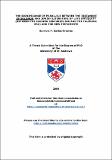Files in this item
The significance of parallels between the 'Testament of Solomon' and Jewish literature of late antiquity (between the closing centuries BCE and the Talmudic era) and the New Testament
Item metadata
| dc.contributor.advisor | Davila, James R. | |
| dc.contributor.author | Davies-Browne, Bankole P. | |
| dc.coverage.spatial | 343 | en_US |
| dc.date.accessioned | 2012-06-08T09:58:53Z | |
| dc.date.available | 2012-06-08T09:58:53Z | |
| dc.date.issued | 2004 | |
| dc.identifier | uk.bl.ethos.536658 | |
| dc.identifier.uri | https://hdl.handle.net/10023/2685 | |
| dc.description.abstract | The TSol is a Christian composition of late antiquity which narrates the story about how King Solomon built the Temple of God with the aid of demons he subjugated. Comparative analysis between the TSol and Jewish literature of late antiquity (between the closing centuries BCE and the Talmudic era), and the New Testament is primarily to establish any literary dependence and explore the nature of contact between the TSol and these materials; and also to isolate Jewish elements in the TSol. The Jewish materials discussed are the Hebrew Bible, the LXX, Tobit, Wisdom of Solomon, Pseudo-Philo, certain Qumran documents (11 PsApa and the Copper scroll), Josephus' Jewish Antiquities, Ecclesiastes, Proverbs, Song of Songs, rabbinic literature, and certain Aramaic incantation texts. My research has shown that parallels do exist between the TSol, the Jewish literature discussed and the New Testament. The parallels between the TSol and the aforementioned literature are twofold: verbal and conceptual. Verbal parallels occur in the form of technical terminology; quotations, allusions and echoes. The second type of parallels appears in the form of motifs, themes, structural elements and ideas. These parallels seem to dominate in my analysis. There is no need to explain the parallels between the TSol and the literature discussed in terms of literary dependence. I have attempted to demonstrate that these parallels in most of the literature are indicative of indirect influence through shared use of the biblical tradition: motifs, stories and themes regarding King Solomon; a common fund of oral tradition(s) regarding Solomon's magical power over demonic world; shared literary language, milieu, and cultural conventions. Moreover, the author of the TSol seems to have recycled Jewish materials pertaining to Solomon and related motifs in his work. Apart from the New Testament, the best case for a direct influence of a Jewish work on the TSol is Tobit. | en_US |
| dc.language.iso | en | en_US |
| dc.publisher | University of St Andrews | |
| dc.subject.lcc | BS1700.D28 | |
| dc.subject.lcsh | Testament of Solomon--Criticism, interpretation, etc. | en_US |
| dc.subject.lcsh | Apocryphal books (Old Testament)--Criticism, interpretation, etc. | en_US |
| dc.subject.lcsh | Jewish literature--Criticism, interpretation, etc. | en_US |
| dc.subject.lcsh | Bible. N. T.--Criticism, interpretation, etc. | en_US |
| dc.title | The significance of parallels between the 'Testament of Solomon' and Jewish literature of late antiquity (between the closing centuries BCE and the Talmudic era) and the New Testament | en_US |
| dc.type | Thesis | en_US |
| dc.type.qualificationlevel | Doctoral | en_US |
| dc.type.qualificationname | PhD Doctor of Philosophy | en_US |
| dc.publisher.institution | The University of St Andrews | en_US |
This item appears in the following Collection(s)
Items in the St Andrews Research Repository are protected by copyright, with all rights reserved, unless otherwise indicated.

